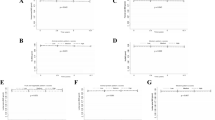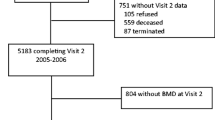Abstract
The aim of this study was to investigate the relationship between dietary habits and hip bone health in community-dwelling individuals with chronic stroke. The usual dietary intake of 94 individuals with chronic stroke (30 women, mean age: 59.0 years) was assessed by a 3-day food record within a single week. Dual-energy X-ray absorptiometry was used to measure bone mineral density (BMD) at both hips. The results showed that low hip bone mass was found in 59 and 50 of the participants on the affected and unaffected side, respectively. The mean hip BMD was also significantly lower on the affected side than the unaffected side (P < 0.001). The intake of total fat, carbohydrates, calcium, magnesium, iron, zinc, fiber, folic acid, vitamin B1, B2, B3, B6, C, and K was significantly lower than the respective recommended daily intake values (P < 0.05). Multiple regression analyses revealed that after adjusting for the effects of age, sex, body mass index, post-stroke duration, side of paresis, motor impairment, physical activity level, walking endurance, total calories intake, and total number of medications, intake of protein, fiber, and magnesium remained significantly associated with hip T score on the affected side, accounting for 4.2, 4.4, and 3.2% of the variance, respectively. On the other hand, intake of protein and fiber was independently associated with hip T score on the unaffected side, explaining 2.7 and 5.2% of the variance, respectively. The results highlighted the potential relevance of diet modification in maintaining bone health post stroke, which would require further study.
Similar content being viewed by others
References
Eng JJ, Pang MYC, Ashe MA (2008) Balance, falls, and bone health: role of exercise in reducing fracture risk after stroke. J Rehabil Res Dev 45:297–314
Melton LJ, Brown RD, Achenbach SJ, O’Fallon WM, Whisnant JP (2001) Long-term fracture risk following ischemic stroke: a population-based study. Osteoporos Int 12:980–986
Dennis MS, Lo KM, McDowall M, West T (2002) Fractures after stroke: frequency, types, and associations. Stroke 33:728–734
Sato Y (2000) Abnormal bone and calcium metabolism in patients after stroke. Arch Phys Med Rehabil 81:117–121
Pocock NA, Eisman JA, Hopper JL, Yeates MG, Sambrook PN, Eberl S (1987) Genetic determinants of bone mass in adults. A twin study. J Clin Invest 80:706–710. doi:10.1172/JCI113125
Ilich JZ, Brownbill RA, Tamborini L (2003) Bone and nutrition in elderly women: protein, energy, and calcium as main determinants of bone mineral density. Eur J Clin Nutr 57:554–565. doi:10.1038/sj.ejcn.1601577
Freudenheim JL, Johnson NE, Smith EL (1986) Relationships between usual nutrient intake and bone-mineral content of women 35–65 years of age: longitudinal and cross-sectional analysis. Am J Clin Nutr 44:863–876
Hodges SJ, Akesson K, Vergnaud P, Obrant K, Delmas PD (1993) Circulating levels of vitamin K1 and K2 decreased in elderly women with hip fracture. J Bone Miner Res 8:1241–1245. doi:10.1002/jbme.5650081012
Sato Y, Tsuru T, Oizumi K, Kaji M (1999) Vitamin K deficiency and osteopenia in disuse-affected limbs of vitamin D-deficient elderly stroke patients. Am J Phys Med Rehabil 78:317–322
Sato Y, Kuno H, Kaji M, Oshima Y, Asoh T, Oizumi K (1998) Increased bone resorption during the first year after stroke. Stroke 29:1373–1377
Uluduz D, Adil MM, Rahim B, Gilani WI, Rahman HA, Gilani SI, Qureshi AI (2014) Vitamin D deficiency and osteoporosis in stroke survivors: an analysis of National Health and Nutritional Examination Survey (NHANES). J Vasc Interv Neurol 7:23–28
Luhrmann PM, Herbert BM, Gaster C, Neuhauser-Berthold M (1999) Validation of a self-administered 3-day estimated dietary record for use in the elderly. Eur J Nutr 38:235–240
Smith-Warner SA, Elmer PJ, Fosdick L, Tharp TM, Randall B (1997) Reliability and comparability of three dietary assessment methods for estimating fruit and vegetable intakes. Epidemiology 8:196–201
Kamper SJ, Maher CG, Mackay G (2009) Global rating of change scales: a review of strengths and weaknesses and considerations for design. J Man Manip Ther 17:163–170. doi:10.1179/jmt.2009.17.3.163
Vaughan K, Miller WC (2013) Validity and reliability of the Chinese translation of the Physical Activity Scale for the Elderly (PASE). Disabil Rehabil 35:191–197. doi:10.3109/09638288.2012.690498
Gowland C, Stratford P, Ward M, Moreland J, Torresin W, Hullenaar SV, Sanford J, Barreca S, Vanspall B, Plews N (1993) Measuring physical impairment and disability with the Chedoke-McMaster stroke assessment. Stroke 24:58–63
Eng JJ, Dawson AS, Chu KS (2004) Submaximal exercise in persons with stroke: test-retest reliability and concurrent validity with maximal oxygen consumption. Arch Phys Med Rehabil 85:113–118
Chinese Nutrition Society: Chinese Dietary Reference Intakes 2013 Version (2014) Beijing: Science China Press
U.S. Department of Agriculture and U.S. Department of Health and Human Services (2010) Dietary guidelines for Americans, 7th edn. U.S Government Printing Office, Washington
Chad KE, Reeder BA, Harrison EL, Ashworth NL, Sheppard SM, Schultz S, Bruner BG, Fisher K, Lawson JA (2005) Profile of physical activity levels in community-dwelling older adults. Med Sci Sports Exerc 37:1774–1784
Chan R, Woo J, Lau W, Leung J, Xu L, Zhao XH, Yu W, Lau E, Pocock N (2009) Effects of lifestyle and diet on bone health in young adult Chinese women living in Hong Kong and Beijing. Food Nutr Bull 30:370–378
Wolf RL, Cauley JA, Baker CE, Ferrell RE, Charron M, Caggiula AW, Salamone LM, Heaney RP, Kuller LH (2000) Factors associated with calcium absorption efficiency in pre-and perimenopausal women. Am J Clin Nutr 72:466–471
Chen Z, Stini WA, Marshall JR, Martinez ME, Guillen-Rodriguez JM, Roe D, Alberts DS (2004) Wheat bran fiber supplementation and bone loss among older people. Nutrition 20:747–751. doi:10.1016/j.nut.2004.05.015
Bergman CJ, Gualberto DG, Weber CW (1997) Mineral binding capacity of dephytinized insoluble fiber from extruded wheat, oat and rice brans. Plant Foods Hum Nutr 51:295–310
Weaver CM, Heaney RP, Teegarden D, Hinders SM (1996) Wheat bran abolishes the inverse relationship between calcium load size and absorption fraction in women. J Nutr 126:303–307
Heaney RP, Weaver CM (1993) Oxalate in vegetables: effect on calcium absorbability. J Bone Miner Res 8:S333
Coudray C, Bellanger J, Castiglia-Delavaud C, Remesy C, Vermorel M, Rayssignuier Y (1997) Effect of soluble or partly soluble dietary fibers supplementation on absorption and balance of calcium, magnesium, iron and zinc in healthy young men. Eur J Clin Nutr 51:375–380
Prynne CJ, Mishra GD, O’Connel MA, Muniz G, Laskey MA, Yan L, Prentice A, Ginty F (2006) Fruit and vegetable intakes and bone mineral status: a cross-sectional study in 5 age and sex cohorts. Am J Clin Nutr 83:1420–1428
Feskanich D, Willett WC, Stampfer MJ, Colditz GA (1996) Protein consumption and bone fractures in women. Am J Epidemiol 143:472–479
Sellmeyer DE, Stone KL, Sebastian A, Cummings SR (2001) The Study of Osteoporotic Fractures Research Group: a high ratio of dietary animal to vegetable protein increases the rate of bone loss and the risk of fracture in postmenopausal women. Am J Clin Nutr 73:118–122
Genaro Pde S, Pinheiro Mde M, Szejnfeld VL, Martini LA (2015) Dietary protein intake in elderly women association with muscle and bone mass. Nutr Clin Pract 30:283–289. doi:10.1177/0884533614545404
Kerstetter JE, O’Brien KO, Insogna KL (2003) Low protein intake: the impact on calcium and bone homeostasis in humans. J Nutr 133:855S–861S
Mangano KM, Sahni S, Kerstetter JE (2014) Dietary protein is beneficial to bone health under conditions of adequate calcium intake: an update on clinical research. Curr Opin Clin Nutr Metab Care 17:69–74
O’Neil CK, Evans E (2003) Beyond calcium and vitamin D. Clin Rev Bone Miner Metab 2:325–339
Orchard TS, Larson JC, Alghothani N, Bout-Tabaku S, Cauley JA, Chen Z, LaCroix AZ, Wactawski-Wende J, Jackson RD (2004) Magnesium intake, bone mineral density, and fractures: results from the Women’s Health Initiative Observational Study. Am J Clin Nutr 99:926–933. doi:10.3945/ajcn.113.067488
Houtkooper LB, Ritenbaugh C, Aickin M, Lohman TG, Going SB, Weber JL, Greaves KA, Boyden TW, Pamenter RW, Hall MC (1995) Nutrients, body composition and exercise are related to change in bone mineral density in premenopausal women. J Nutr 125:1229–1237
Aydin H, Deyneli O, Yavuz D, Gozu H, Mutlu N, Kaygusuz I, Akalın S (2010) Short-term oral magnesium supplementation suppresses bone turnover in postmenopausal osteoporotic women. Biol Trace Elem Res 133:136–143. doi:10.1007/s12011-009-8416-8
Doyle L, Flynn A, Cashman K (1999) The effect of magnesium supplementation on biochemical markers of bone metabolism or blood pressure in healthy young adult females. Eur J Clin Nutr 53:255–261
Pang MY, Yang FZ, Jones AY (2013) Vascular elasticity and grip strength are associated with bone health of the hemiparetic radius in people with chronic stroke: implications for rehabilitation. Phys Ther 93:774–785. doi:10.2522/ptj.20120378
Cvijetic S, Korsic M (2004) Apparent bone mineral density estimated form DXA in healthy men and women. Osteoporos Int 15:295–300. doi:10.1007/s00198-003-1525-x
Bainbridge NJ, Davie MW, Haddaway MJ (2006) Bone loss after stroke over 52 weeks at os calcis: influence of sex, mobility and relation to bone density at other sites. Age Ageing 35:127–132
Anderson JJ, Roggenkamp KJ, Suchindran CM (2012) Calcium intakes and femoral and lumbar bone density of elderly US men and women: national Health and Nutrition Examination Survey 2005–2006 analysis. J Clin Endocr Metab 97:4531–4539. doi:10.1210/jc.2012-1407
Kim KM, Choi SH, Lim S, Moon JH, Kim JH, Kim SW, Jang HC, Shin CS (2014) Interactions between dietary calcium intake and bone mineral density or bone geometry in a low calcium intake population (KNHANES IV 2008–2010). J Clin Endocr Metab 99:2409–2417. doi:10.1210/jc.2014-1006
Calvo MS, Park YK (1996) Changing phosphorus content of the US diet: potential for adverse effects on bone. J Nutr 126:1168S
Woo J, Ho SC, Goggins W, Chau PH, Lo SV (2014) Stroke incidence and mortality rates in Hong Kong: implications for public health education efforts and heath resource utilisation. Hong Kong Med J 20:S24–S29
Acknowledgements
This study was supported by a research grant provided by the Service Wellness Centre (Grant Number 8-ZD78).
Author information
Authors and Affiliations
Contributions
S.K.Y.L contributed to statistical analysis of data, interpretation of data, and prepared the first draft of the paper. M.M.P.W designed the study and contributed to the acquisition of data, statistical analysis, and interpretation of data. F.P.L.S and S.C contributed to the acquisition of data, and interpretation of data. M.Y.C.P designed the study, interpretation of data, and was responsible for project management. He is guarantor. All authors revised the paper critically for intellectual content and approved the final version. All authors agree to be accountable for the work and to ensure that any questions relating to the accuracy and integrity of the paper are investigated and properly resolved.
Corresponding author
Ethics declarations
Conflict of interest
The authors declare that they have no conflicts of interests.
Human and Animal Rights
All procedures performed in studies involving human participants were in accordance with the ethical standards of the institutional and/or national research committee and with the 1964 Helsinki declaration and its later amendments or comparable ethical standards.
Informed Consent
Informed consent was obtained from all individual participants included in the study.
Rights and permissions
About this article
Cite this article
Li, S.K.Y., Wan, M.M.P., Siu, F.P.L. et al. Relationship Between Nutritional Factors and Hip Bone Density in Individuals with Chronic Stroke. Calcif Tissue Int 101, 259–270 (2017). https://doi.org/10.1007/s00223-017-0276-1
Received:
Accepted:
Published:
Issue Date:
DOI: https://doi.org/10.1007/s00223-017-0276-1




